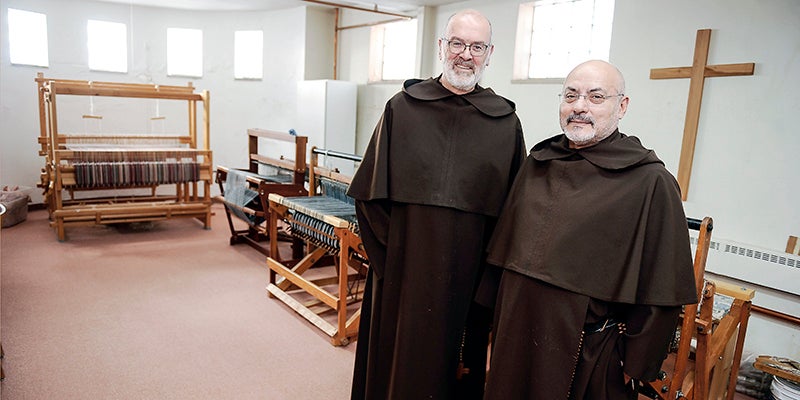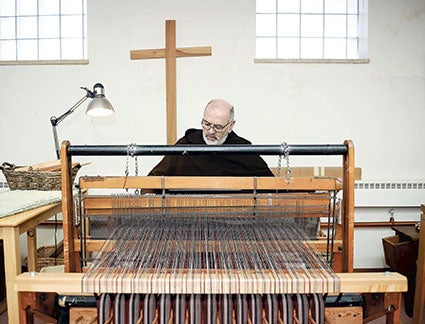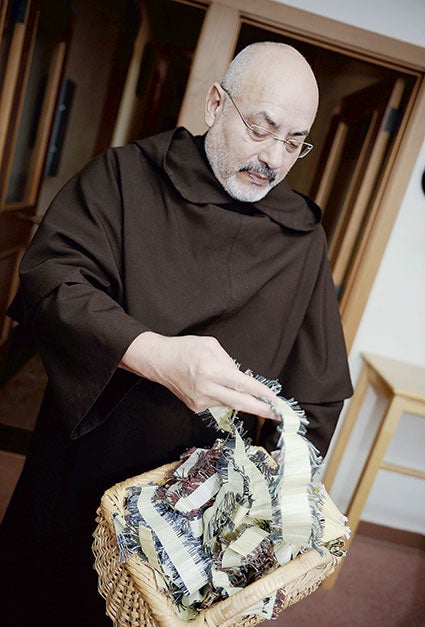‘School of Prayer’: Austin Carmelites live life of labor, solitude and prayer
Published 1:01 pm Sunday, March 19, 2017

- In the basement of Annunciation Hermitage Order of Carmelites in Austin, Father John and Brother Henry weave rugs on several looms for sale from the hermitage. Eric Johnson
“The Apostle would have us keep silence, for in silence he tells us to work. As the Prophet also makes known to us: Silence is the way to foster holiness. Elsewhere he says: Your strength will lie in silence and hope …” – Rule of St. Albert
You will not often see the brothers of the Annunciation Hermitage Order of Carmelites in Austin – and in some ways, even though it seems odd, that is their gift.

Read the entire story including what the Order of Carmelites have to offer in this latest edition of Austin Living Magazine. Get your copy today!
They are called to the Order of Carmelites to separate themselves from the distraction of today’s existence by embracing a life of solitude, contemplation and unceasing prayer in praise of Christ and for the salvation of all souls.
Among their other gifts are their labors, whose results are perhaps more visible to the community at large, from their skill in creating woven rugs to the soaps, jams and jellies they produce.
The Hermitage, as described by its inhabitants, has been “a school for prayer” housed at Queen of Angels Catholic Church since 2001. The rooms, which include a small chapel, were at one time home to Franciscan sisters who taught at Austin Catholic Schools.
There are currently two brothers in the Hermitage, Father Jon and Brother Henry. Their welcome to visitors this day is marked by a friendly invitation to gather in their main room of muted gold carpet and pale walls. Their furniture is sturdy but comfortable. A The bright red of a holiday poinsettia brightens a corner where a fireplace sits. The walls are largely unadorned except for icons. One end of the main expanse holds items of homemade items for sale.
The balance of rooms includes their workspace for their rugs, a study whose east end includes many plants, a kitchen and their personal rooms, called cells.
At different parts of the year, the Hermitage, considered a small monastery, may be home to as many as six brothers. Others may be guests; or those seeking retreat, whose time at the Hermitage allows them to reflect on a potential calling. Novitiates use such time to see if they can handle the overwhelming commitment. A brother must take a vow of poverty, celibate chastity, and obedience.
“We do not have TVs or use the internet,” said Father Jon who, like Brother Henry, wears the signature Carmelite tunic of deep brown, a scapular – a short cloak worn on the shoulders – and a capuche, or hood.
“It is a life based on solitude and prayer. You have to be mature” to embrace it, agreed Brother Henry. “It can be very challenging. It’s a life that knocks out any controls you may have. It is a life of faith.”
They may have walked from different paths but their love of the Carmelite life is a bond.
For Father Jon, it came through an awakening to the Carmelite principles as an ordained Roman Catholic priest living in the Diocese of Winona.
“I have always been attracted to the monastic life,” said Father Jon. “It always intrigued me.”

Father Jon works one of the many looms in the basement of the Annunciation Hermitage Order of Carmelites in Austin. Eric Johnson
Brother Henry said he was also drawn to the eremitic life, a life of seclusion, as a teenager in Tucson, Arizona. He has served in the Carmelite order since he was 19.
Most Carmelite orders are established in relatively small houses, said Father Jon, “simply because the effort was made to live not institutionally, but like family.”
Their days are scheduled by rounds of prayer, reflection and labor. Their day begins at 6 a.m. in prayer and reading of scripture, followed by Mass. The brothers work on their crafts primarily in the morning, while the afternoons may include more work, study or some type of housekeeping. Time for prayers and meditation accent the days, ending in compline – or evening – prayers. The men only share common time two times of the day – at midday prayer and dinner; and vespers.
Mornings are spent weaving rugs. About once a month the brothers will put up 200 jars of preserves (“Hot is the best,” confided Brother Henry, of the jalapeno-laced jam) and roughly every other month, they create scented soaps. There is also Carmelite coffee for sale in different blends.
But weaving is the main focus of their labor. Their workroom is lined with looms; one large one is used only for items used by the brothers. The rest are set up for a maximum of 28-inch widths and made to varying lengths.
It takes a day, said Brother Henry, to warp a loom – the intricate stringing with thread that will hold the lengths of fabric that become the rug base. Lengths of narrow material are shuttled back and forth – again and again and again between the threads – a process that may seem boring to some. In the case of the brothers, it is a way to combine manual labor with meditation.
Creating items for sale is common within Carmelite orders; it is a way to help support its mission.
The rugs are varied and their look is at the mercy, so to speak, of Eddie Bauer. The clothing company has a manufacturing plant in the Twin Cities; its end rolls, including the selvage ends, are offered to anyone who wants them. The brothers contract with a quilter who selects ones she believes the brothers will like. The selvage end is cut off and the fabric cut to particular widths for the rugs. The sewing of the ends is done by volunteers, said Father Jon.

Brother Henry shows off some of the fabric used in creating the rugs at the Annunciation Hermitage Order of Carmelites in Austin. Eric Johnson
“We are very fortunate to have these,” he said, pointing to different fabrics ready for the loom.
Normally, it takes a few hours to weave a normal rug that is later priced between $30 and $50, depending on its length. The rugs, like the soaps, preserves and Carmelite coffee, will eventually be sold at farmer’s markets or right from the Hermitage.
The brothers find that their preserves – called St. Joseph’s Preserves, are popular and include such flavors as Jalapeno Jelly, Raspberry Champagne, Strawberry Rhubarb or Blueberry Rhubarb. There are also wine flavors.
Their Monastery Soaps – scented with oils such as lavender, lemon or rose—are created, like the preserves, out of the small Hermitage kitchen. The soap has natural ingredients, such as honey and oatmeal.
Carmelite Coffees, organic and fair trade are not created at the Hermitage, but the selection of beans and blends are done by the brothers. They also named the special blends to reflect life at the Hermitage, including “Weaver’s Blend” to highlight their labors at the loom; “Arbor Rest,” pays tribute to a special enclosure that is favored for reflection and prayer. “Gardener’s Pick” denotes their love of gardening fruit, vegetables and flowers.
The life of labor, prayer and contemplation, said Father Jon, “works for us” and are willing to talk to those who want to learn more about pursuing that life.
Or, if you are interested in supporting the Hermitage and the work of the brothers, you may contact them at 507-437-4015 or: annunciationhermitage@q.com.






